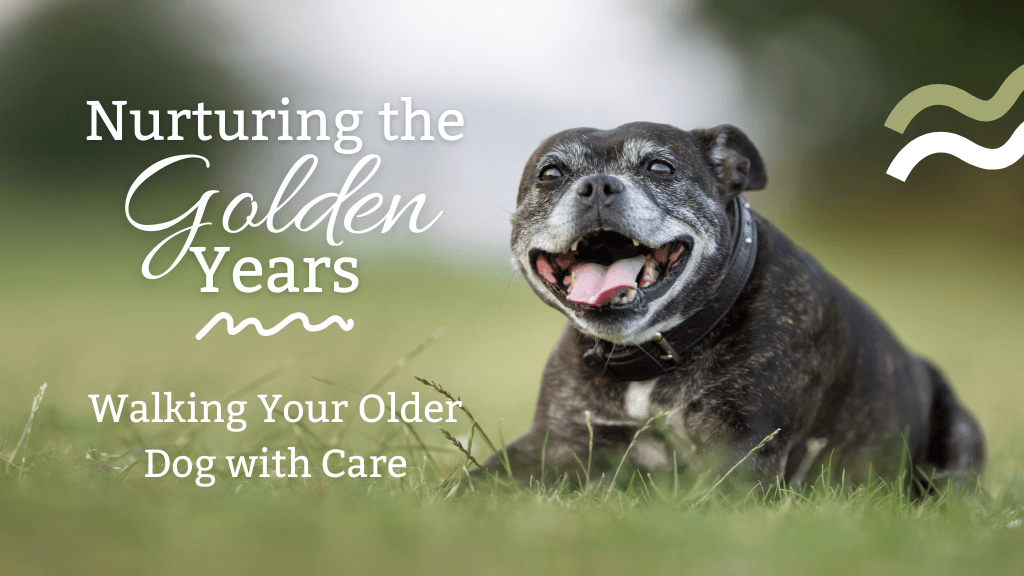Walking Your Senior Dog: Tips for Comfort and Care in Their Golden Years
)
As our loyal companions age, their needs change, and caring for them becomes even more important. One aspect of their well-being that often requires special attention is exercise, particularly daily walks. While regular walks remain beneficial, older dogs need a little extra care and consideration. In this blog, we’ll discuss how to adapt your walking routine for senior dogs, taking into account their age, health, and comfort. From joint care to the right walking gear, we’ll guide you through everything you need to know to ensure your senior dog enjoys safe and enjoyable strolls well into their golden years.
Check with the Vet First:
Before setting out on a regular walking routine for your older dog, it’s always a good idea to consult your vet. Our friendly team at North Road Veterinary Centre will help assess your dog’s overall health, taking into account their medical history, current physical condition, and any signs of discomfort. This allows us to recommend a tailored exercise plan that suits your senior dog’s specific needs, ensuring that their walks are not only enjoyable but also safe.
Caring for Joints and Muscles:
As dogs age, their joints and muscles become more prone to issues like arthritis, which can make walking uncomfortable. To help ease their joint pain, choose softer surfaces like grass or well-maintained paths to reduce impact during walks. You might also want to consider introducing joint supplements, which can improve mobility and reduce discomfort, giving your dog more energy and enthusiasm for their daily outings.
Adjusting the Length and Intensity:
Even if your dog is still excited about their daily walks, it’s important to recognise their changing limits. Senior dogs may not have the same stamina they once did, so shorter, more frequent walks are often the best option. Quality is more important than quantity—keeping the walks relaxed and enjoyable ensures your dog stays active without becoming overly tired.
Watching for Signs of Discomfort:
While walking your senior dog, pay close attention to their body language. If you notice them limping, panting more than usual, or hesitating to continue, it’s a sign that they may need to take a break or have their exercise routine adjusted. Being aware of these subtle cues helps you make sure that walks remain comfortable and enjoyable for your dog, ensuring their overall well-being.
Weather Considerations:
Older dogs are more sensitive to extreme weather conditions, so it’s important to plan walks accordingly. During hot weather, aim for early morning or evening walks to avoid the heat. On chilly days, keep your dog warm with a cosy coat, particularly if they have a thin coat or are prone to getting cold.
Choosing the Right Gear:
As dogs age, their walking gear becomes more important than ever. Traditional collars can put strain on their necks, so switching to a harness is a gentler option. A well-fitted harness helps distribute pressure more evenly across the body, ensuring a more comfortable and safer walk for your senior dog.
Mental Stimulation on Walks:
Walks are not just about physical exercise—they’re also an opportunity for mental stimulation. Allow your dog to explore and sniff their surroundings, as this helps keep their mind sharp and engaged. For older dogs, mental activity is just as important as physical movement, and letting them take in their environment keeps them mentally fit and happy.
Regular Vet Check-ups:
Routine check-ups are key to keeping your senior dog in top condition. These visits allow you to discuss any changes in behaviour, health, or diet with your vet. As dogs age, their dietary needs may shift, and regular vet consultations ensure their nutrition is optimised for vitality in their golden years.
Don't forget about the heart warming stuff!
Finally, walks offer a wonderful opportunity to strengthen the bond between you and your senior dog. These shared moments bring joy and emotional support to your dog, who treasures your company more than ever. Slowing down and going at their pace creates a heartwarming experience for both of you, enhancing the deep connection you’ve built over the years.
To sum it up, walking your senior dog is an essential part of their care routine, providing physical, mental, and emotional benefits. With proper adjustments, regular vet visits, and attention to their changing needs, your loyal companion can continue enjoying the simple pleasures of a daily walk throughout their golden years.

| Tags:DogClient InformationHealth AdviceProactive Pet Care |
&geometry(126x115))